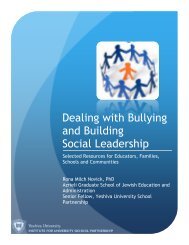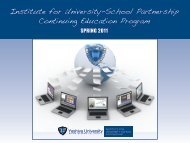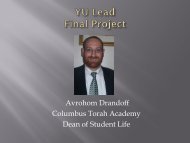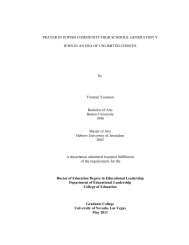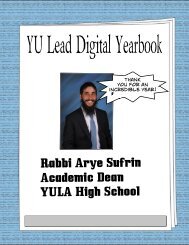grade conferences, etc., effective pr<strong>in</strong>cipals, accord<strong>in</strong>g to Blasé<strong>and</strong> Blasé (2004), make suggestions, give feedback, model, use<strong>in</strong>quiry, <strong>and</strong> solicit op<strong>in</strong>ions from teachers.b. Provid<strong>in</strong>g staff development: Accord<strong>in</strong>g to Blasé <strong>and</strong> Blasé(2004), “Behaviors associated with provid<strong>in</strong>g staffdevelopment <strong>in</strong>clude emphasiz<strong>in</strong>g the study of teach<strong>in</strong>g <strong>and</strong>learn<strong>in</strong>g, support for collaboration, development of coach<strong>in</strong>grelationships, use of action research, provision of resources,<strong>and</strong> application of the pr<strong>in</strong>ciples of adult growth <strong>and</strong>development to all phases of the staff development program”(p. 162).c. Encourag<strong>in</strong>g teacher reflection: Effective pr<strong>in</strong>cipalspurposefully engage teachers <strong>in</strong> articulat<strong>in</strong>g feel<strong>in</strong>gs, shar<strong>in</strong>gattitudes, <strong>and</strong> deep th<strong>in</strong>k<strong>in</strong>g about <strong>in</strong>structional issues(Carroll, Featherstone, Featherstone, Feiman-Nemser, &Roosevelt, 2007; Farrell, 2003; Lasley, 1992; Schon, 1987).Vignette: About five years ago I visited a high school on thewest coast. A friend I had known <strong>in</strong> college, but had not seen<strong>in</strong> thirty years, was the new pr<strong>in</strong>cipal. We began rem<strong>in</strong>isc<strong>in</strong>gabout college but then the conversation turned ‘pedagogical.’ Idiscussed my research <strong>and</strong> work on teach<strong>in</strong>g, supervision, <strong>and</strong>my vision for good school<strong>in</strong>g when he suddenly <strong>in</strong>terrupted<strong>and</strong> assertively stated, “Now Jeffrey, you don’t believe thatgarbage do you? ‘Professional learn<strong>in</strong>g communities,’ give mea break. Did we have them when we were <strong>in</strong> high school? Weturned out pretty damn good, didn’t we? I learned history <strong>and</strong>math primarily through memorization <strong>and</strong> I was able to tieth<strong>in</strong>gs together us<strong>in</strong>g my own faculties. We rarely had PD.We knew how to th<strong>in</strong>k on our feet. This teach<strong>in</strong>g th<strong>in</strong>g, youknow is all <strong>in</strong>tuitive. If I had a question, I’d ask a colleague . . .no need for meet<strong>in</strong>g after meet<strong>in</strong>g. I agree, though,”cont<strong>in</strong>u<strong>in</strong>g his tirade, “teachers today are really a sad lot; theyare ill-prepared, . . . don’t even know their content; I have tospoon feed them. There’s no discipl<strong>in</strong>e <strong>in</strong> this school <strong>and</strong> Idon’t mean the kids. I have to run a tight ship, . . . be toughwith teachers; they have to know who’s the boss.” He later10
admitted that he had spewed forth this “pedagogicalcorrectness” about <strong>in</strong>volv<strong>in</strong>g teachers, <strong>in</strong>vit<strong>in</strong>g greaterparental <strong>in</strong>volvement, build<strong>in</strong>g team spirit, etc. dur<strong>in</strong>g the<strong>in</strong>terviews because he knew “what the committee wanted tohear” but that while he articulated such views he didn’tbelieve <strong>in</strong> them <strong>and</strong>, certa<strong>in</strong>ly, didn’t act on them.<strong>Instructional</strong> supervision, as best practice, is a school-wide process<strong>in</strong> which teach<strong>in</strong>g <strong>and</strong> learn<strong>in</strong>g become the core of the school’smission. Pr<strong>in</strong>cipals <strong>and</strong> other adm<strong>in</strong>istrators work to develop aprofessional learn<strong>in</strong>g community that supports such work (Burke &Krey, 2005; Hord, Rouss<strong>in</strong>, & Sommers, 2009; Morrissey, 2000;Sullivan & Glanz, 2006; Ubben, Hughes, & Norris, 2004). Aprofessional learn<strong>in</strong>g community has five dimensions: (1) supportive<strong>and</strong> shared leadership (e.g., school adm<strong>in</strong>istrators participatedemocratically with teachers shar<strong>in</strong>g power, authority, <strong>and</strong> decisionmak<strong>in</strong>g); (2) shared values <strong>and</strong> vision (e.g., the pr<strong>in</strong>cipal or head <strong>and</strong>staff decide on the values <strong>and</strong> vision of the school <strong>and</strong> support itsrealization); (3) collective learn<strong>in</strong>g (e.g., staff <strong>and</strong> the adm<strong>in</strong>istrationcome together to learn how best to improve student performance); (4)supportive conditions (e.g., pr<strong>in</strong>cipals <strong>and</strong> teachers possess adequateresources to promote <strong>in</strong>structional excellence <strong>and</strong> create structuresthat facilitate learn<strong>in</strong>g for all); <strong>and</strong> (5) shared personal practice (e.g.,peer review <strong>and</strong> feedback are school norms as is feedback given toadm<strong>in</strong>istrators by teachers <strong>in</strong> <strong>in</strong>formal <strong>and</strong> formal ways) (Hord, 1997as cited by Morrissey, 2000, pp. 4, 32-33). <strong>Instructional</strong> leaders with<strong>in</strong>professional learn<strong>in</strong>g communities keep <strong>in</strong>structional quality as theirma<strong>in</strong> focus.In order to provide a theoretical frame for discussion of<strong>in</strong>structional quality (as measured by student learn<strong>in</strong>g), see Figure 1below that highlights the key components of <strong>in</strong>struction: teach<strong>in</strong>g,curriculum, <strong>and</strong> professional development (supervision). <strong>Instructional</strong>quality is achieved through excellent teach<strong>in</strong>g, facilitated by cutt<strong>in</strong>gedgepractices <strong>in</strong> professional development, <strong>and</strong> an articulated <strong>and</strong>deep underst<strong>and</strong><strong>in</strong>g of the content skills <strong>and</strong> values embedded <strong>in</strong> thecurriculum. Therefore, an exam<strong>in</strong>ation or audit of a school’s<strong>in</strong>structional or educational quality must necessarily encompass a11
- Page 1 and 2: Improving InstructionalQuality in J
- Page 4 and 5: Appendix C: Assessing Your Role as
- Page 6 and 7: others, involved in a cognate enter
- Page 8 and 9: Weissberg, Walberg, & Wang., 2004).
- Page 10 and 11: all. “We are never asked for what
- Page 12 and 13: administrator. He was well-organize
- Page 14 and 15: Sartoris, DiPrima Bickel, & Garnier
- Page 18 and 19: school’s teaching practices, the
- Page 20 and 21: een made in the areas of science an
- Page 22 and 23: learning is more likely to occur th
- Page 24 and 25: content, and the need to ensure tha
- Page 26 and 27: pattern.] I didn’t really realize
- Page 28 and 29: constraints, increase in administra
- Page 30 and 31: The Transformational Change Project
- Page 32 and 33: that are not strategic, but episodi
- Page 34 and 35: my personal involvement in work wit
- Page 36 and 37: schools to even greater levels of s
- Page 38 and 39: was: “Well, you know, finding tim
- Page 40 and 41: called direct teaching), although e
- Page 42 and 43: surprised when no one can answer
- Page 44 and 45: RecommendationsI. Teaching1. Teache
- Page 46 and 47: standards,” a significant opportu
- Page 48 and 49: decide on an area or theme they’d
- Page 50 and 51: • Reflective journaling - Another
- Page 52 and 53: 3. Deep instructional improvement v
- Page 54 and 55: Instructional leadership is about e
- Page 56 and 57: 76). Teachers who employ instructio
- Page 58 and 59: short answers to two questions. The
- Page 60 and 61: may become involved in cooperative
- Page 62 and 63: utilized within a differentiated le
- Page 64 and 65: Research-Based Teaching Practices i
- Page 66 and 67:
curriculum? Schools, in my view, to
- Page 68 and 69:
learning objectives have been ident
- Page 70 and 71:
Developing curriculum at the planni
- Page 72 and 73:
4) Emphasize both the academic and
- Page 74 and 75:
An Overview of Best Practices in Su
- Page 76 and 77:
with practices best suited to promo
- Page 78 and 79:
dialogue and meaningful supervision
- Page 80 and 81:
• Ongoing - Too much of professio
- Page 82 and 83:
to do so. In fact, utilizing in-sch
- Page 84 and 85:
greatly to meaningful supervision a
- Page 86 and 87:
and amplified by James MacGregor Bu
- Page 88 and 89:
Leadership is predicated on the fou
- Page 90 and 91:
Citing Jim Collins (2002 cited by F
- Page 92 and 93:
Notes1. Before continuing, I sugges
- Page 94 and 95:
ubric of “professional developmen
- Page 96 and 97:
throughs, explains that according t
- Page 98 and 99:
members are not fully cognizant or
- Page 100 and 101:
AcknowledgementsI thank all the ind
- Page 102 and 103:
Bass, B. M. (1985). Leadership and
- Page 104 and 105:
Burke, P. J., & Krey, R. D. (2005).
- Page 106 and 107:
Downey, C. J., Steffy, B. E., Posto
- Page 108 and 109:
Fullan, M. (2005). Leadership and s
- Page 110 and 111:
Good, T., & Brophy, J. E. (2007). L
- Page 112 and 113:
Johnson, C. C., & Fargo, J. D. (201
- Page 114 and 115:
Marzano, R. J., & Brown, J. L. (200
- Page 116 and 117:
Popham, W. J. (2008a). Classroom as
- Page 118 and 119:
Shapira-Lishchinsky, O. (2009). Isr
- Page 120 and 121:
Tschannen-Moran, M., & McMaster, P.
- Page 122 and 123:
Annotated Works on Instructional Le
- Page 124 and 125:
This volume is an inspiring introdu
- Page 126 and 127:
you want to learn how to teach stud
- Page 128 and 129:
AppendicesAppendix A: Instructional
- Page 130 and 131:
Suggested responses:1. To be effect
- Page 132 and 133:
Appendix C: Assessing Your Role as
- Page 134 and 135:
SA A D SD 3. My spoken language as
- Page 136 and 137:
Domain 2: The Classroom Environment
- Page 138 and 139:
SA A D SD 13. I have a well-defined
- Page 140 and 141:
SA A D SD 13. I rarely desire to se
- Page 142 and 143:
20. This is a well managed school.
- Page 144 and 145:
Appendix F: Teacher Attitude Questi
- Page 146:
41. My colleagues and I usually dis




